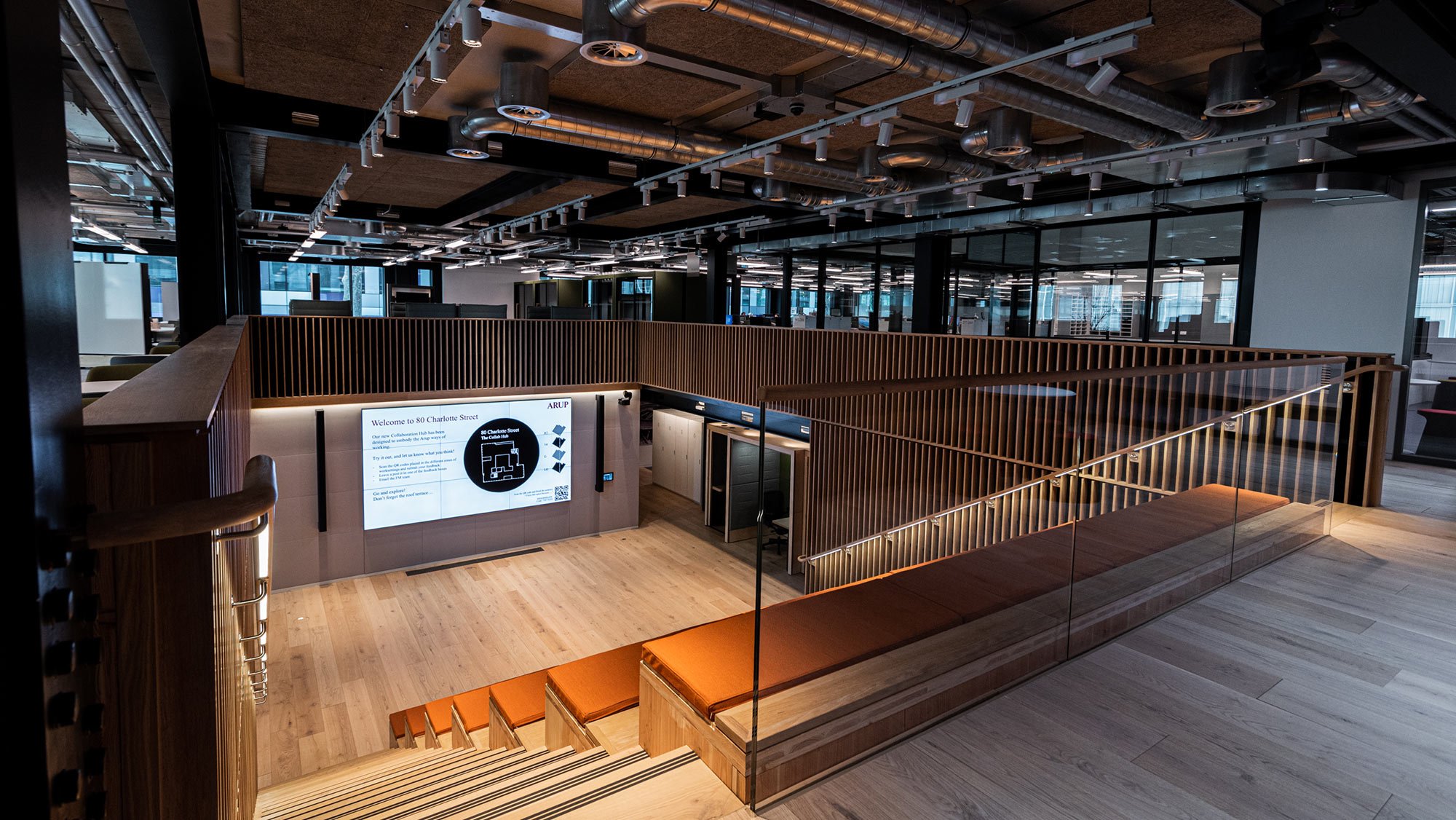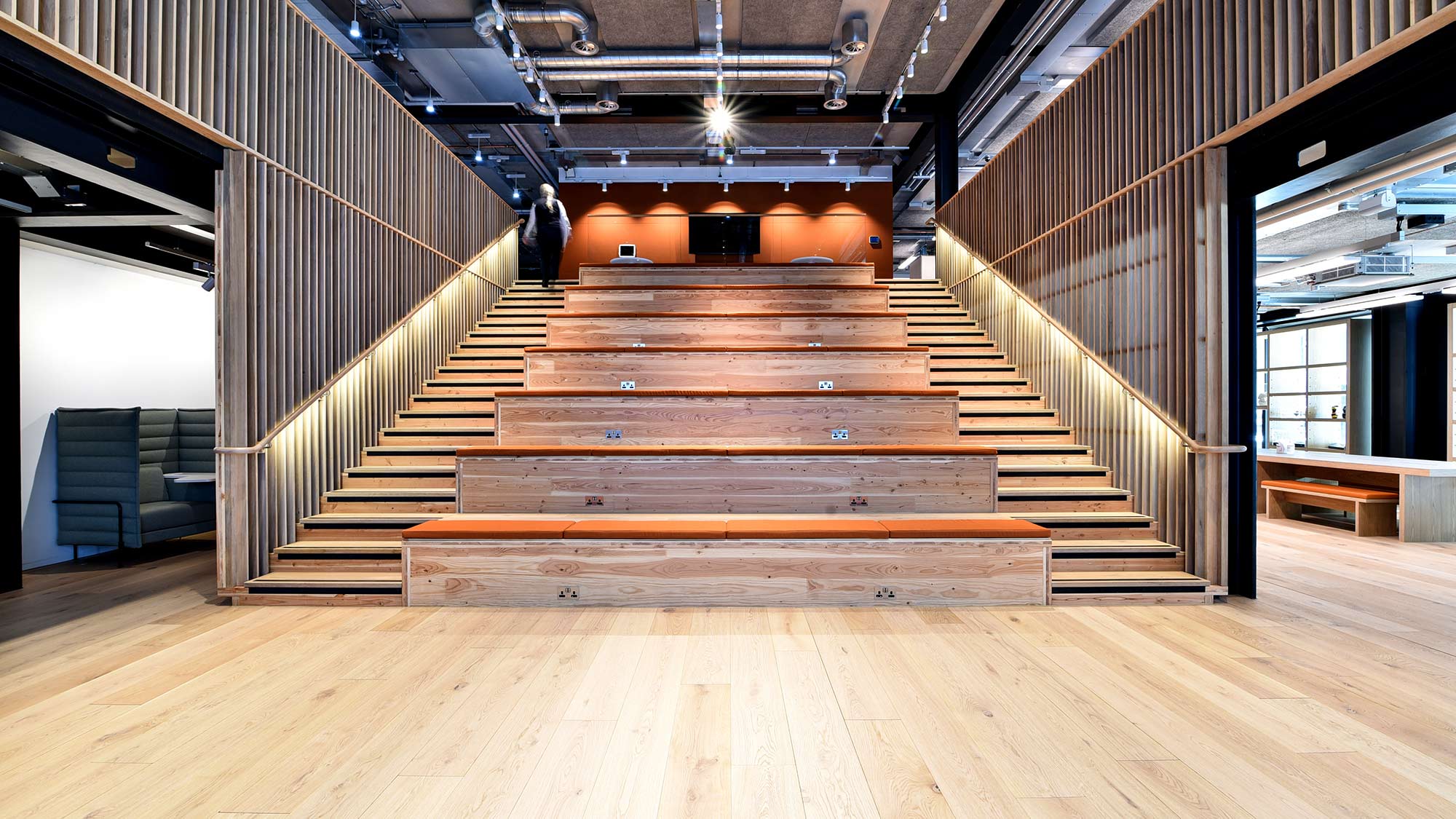There is growing need to understand and measure the carbon emissions produced by the built environment. Although it’s becoming more commonplace to measure the emissions relating to a building’s frame and façade, until recently the fit out has too often escaped the analyst’s eye. This is understandable, given that the final interior form of the building is often decided by the tenant, sometime after the developer has completed the main build. But the fit out has huge implications for embodied carbon emissions.
Industry figures suggest that it is responsible for between 20% and 50% of whole life carbon emissions in buildings. However, these benchmarks are based on assessments of Shell and Core and Cat A finishes only. Assessments of fully fitted out projects by Arup (which include Cat B fit out, furniture fixtures and fittings) suggest the contribution could be much higher- up to 60% higher than the benchmarks for office buildings. This poses some hard decisions about the way we furnish and fit out our internal environments.
The World Green Building Council’s net zero commitment is to reduce overall embodied CO2 emissions from base build and fit out by at least 40% by 2030. Across the industry, major players, including Arup, are making bold commitments – these need to be translated into on-the-ground actions that can be applied on any and every project. None of us can be in any doubt about how hard these targets will be to achieve.
Five insights for lower emission fit outs
Arup has begun to evaluate carbon emissions embedded in fit out. Here are five things we have learned so far:
1. Embodied carbon is everywhere
These are the emissions associated with the energy used in production and transportation of products used to fit out spaces. These include energy-intensive processes to produce materials such as steel, aluminium and plastics. These materials surround us and aren’t exclusive to the structure or façade. From the metal in the raised access floors, to plastic in carpet and furnishings, it’s unsurprising that embodied carbon emissions are racking up.
2. Current benchmarks underestimate emissions
We are still learning to calculate and only beginning to understand the range of embodied carbon emissions associated within our buildings. Methods for embodied carbon assessment of structural elements and facades are well-defined, whilst complex building services systems are more challenging to address, and measurement for furniture, fixtures and equipment is uncommon.
Once we explore fit out emissions, it’s ‘the more you look… the more you find’. This limitation is reflected in current industry benchmarks for carbon. Underlying data to current whole building benchmarks doesn’t account for full fit outs at all, or only partially. We must be ready to commit to greater rigour and transparency if we want to address this problem.
3. Cat A fit outs are wasteful (and should probably end)
Most new buildings are completed to Cat A, yet many tenants then spend time and money (and emissions) ripping them out and starting over, to put their own stamp on a space. This is an own goal and a practice that could end. There is a conversation that needs to happen between developers, landlords and tenants early on. We need to replace generic Cat A fit out with ‘bespoke’ fit out where possible, to avoid wasting material, carbon, money and time. This also brings greater control and responsibility for emissions to the tenant. Industry bodies are pushing for it too; here in the UK the British Council of Offices’ 2022 position paper offers direction on how projects’ approach to embodied carbon should be reformed and improved.
4. Commit to a retention strategy
In an era focused on sustainable choices, the approach of building new should already seem a historical one. As further encouragement, there are huge savings to be made through refurbishment of existing spaces by cleverly retaining existing functional elements. From facades to services to partitions and furniture, there is much that can usually be kept and re-used- it’s just a choice that too often doesn’t get made. For example, a recent review of a Derwent project in London concluded up to 80% savings were possible by retaining existing electric cabling and trunking. This does not just have a cost saving, but an embodied carbon saving.
5. Embrace the circular economy
Our research shows one simple choice can radically reduce fit out emissions: avoid installing new raised access floor systems. These panels, made of particleboard encapsulated in steel, are particularly carbon intensive, and are spread out across the floorplate of most offices. As materials they’re very difficult to recycle as they can’t be deconstructed easily, mostly ending up in landfill to be replaced by something functionally identical. This one factor contributes to approximately 15% of the embodied carbon emissions of Cat B fit outs. So, what to do?
For new builds, there are more sustainable lower emission raised access floor options now on the market. For both new build and refurbishment projects, designers need to approach the project differently to reduce carbon.
Learning from our own buildings
Three recent fit out projects for Arup’s own offices, have helped us to explore the issues the industry faces:
10 George Street, Edinburgh
Innovative, modern and environmentally considerate refurbished state-of-the-art office space in central Edinburgh.
-
100% raised access floor panels retained
-
70% ceiling tiles reused
One Centenary Way, Birmingham
A flexible, sustainable, collaborative new office space for Arup in the heart of Birmingham.
-
37% reduction in WLC by avoiding suspended ceiling and exposing services
-
91 desks, sofas, chairs, and tables reused from Midlands Campus
A circular solution
To summarise how the fit out industry can become more sustainable: we need to measure embodied carbon more accurately and consistently. We also need to embrace the virtues of the circular economy ethos – there’s so much we can retain, reuse or recycle – if only we change our mindset.
With regulation only likely to tighten, an increasing expectation for businesses to report emissions, and an increased focus on refurbishing existing buildings, fit out choices are likely to come to the fore. They’re also another context in which bold thinking can reduce emissions, lower costs and enable more sustainable business operations.
 ;
;

